1936
The Canadian Broadcasting Act, which took effect on November 2, paved the way for the creation of the Radio-Canada French language radio network.
Radio-Canada thereby officially took possession of the facilities of the Canadian Radio Broadcasting Commission (CRBC) and formally went on the air using the call letters CRCM (Commission de la Radio Canadienne à Montréal). The station broadcast its signal from the CFCF antenna. Thanks to revenues totalling some $130,000 during its first year of operations, Radio-Canada was able to purchase a mobile studio.
1937
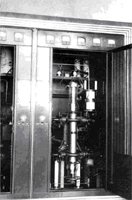
Radio Canada changed its call letters from CRCM to CBF. On December 11, the French language CBF Montreal station was officially opened and it operated on 50,000 watts of power at a frequency of 690 kHz, thereby laying the foundation of the Radio-Canada French language radio network. The Federal Minister of Justice, Ernest Lapointe, and the Minister of Transport, C.D. Howe, attended the station’s inaugural gala that was marked by a symphonic concert, excerpts from a few legendary operas and a number of traditional sketches.
Paradoxically, “CBF” were not radio call letters that had been officially allocated to Canada, but had rather been assigned to Chile. CBF is the acronym for “Canadian Broadcasting French”. An agreement had been reached between Chile and Canada regarding the use of these call letters, because there was indeed an “authentic” CBF in Chile, but it was a Chilean Coast Guard radio station.
The antenna (585 feet) and the transmitter were located at the boundary between the municipalities of Verchères and Contrecoeur. Construction had begun on June 10 under the direction of Auguste Frigon, Assistant Director at Radio-Canada. The cost for these facilities came to $278,000.
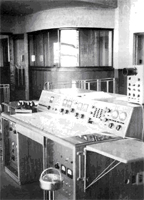
A reinforced concrete anti-bomb shelter was built on the site, which contained the essentials for two people, as well as the instruments that would have been necessary to transmit programs in the event of a bombing raid. At the time, there was one full-time operator at the transmission site and the station never experienced any major interruptions, because redundancy had been built into all the equipment that supplied electric current to the site.
On May 8, His Grace Anastase Forget, the Bishop of Saint-Jean, blessed the facilities during another ceremony. He was accompanied by the Federal Minister of Public Works, the Honourable J.-Arthur Cardin.
1938
The Radio-Canada CBF station began broadcasting the program “Le réveil rural”, a show dedicated to economic information intended for rural inhabitants.
The soap opera “La Pension Velder”, written by Robert Choquette, went on the air for the first time. It was a resounding success and remained on the air until 1942, before being revived on TV in the 1950s, where it once again met with unqualified success.
Marcelle Barthe became the first female journalist on the Radio-Canada French language network. She will work there for some 25 years.
On September 25, CBV Québec the first regional radio station was launched. Initially, it was on the air eight hours a day, with 1,000 watts of transmitter power.
On October 16, CBJ Chicoutimi is the next regional station to begin broadcasting, thereby becoming the third station owned by the Radio-Canada French language radio network.
1939
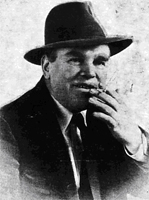
In March, CBF launched the soap opera “Un homme et son péché” based upon the popular Claude-Henri Grignon novel. The soap opera will air for 22 years. In order to intensify the depth of the voice of the announcer, François Bertrand, the director, Guy Maufette, placed the microphone right above the chords of a grand piano.
Radio-Canada was broadcasting four regular news bulletins a day, in cooperation with Canadian Press, but in September, when war was declared, Radio-Canada remained on the air 24 hours a day for a whole month in order to report on all the latest news coming from Europe.
Regular broadcasting of the Montreal Canadians’ hockey games from the Montreal Forum began.
More than 90 programs were devoted to coverage of King George VI’s Royal Visit, which arouses considerable public interest.
Radio-Canada sent a team of announcers and technicians to accompany the Canadian Armed Forces’ First Division to England, right after the outbreak of World War II.
The War Measures Act took effect. The Montreal Censorship Bureau, created by the King Government, continually monitored all the information being broadcast by the French language network. Radio-Canada personnel worked very closely with the BBC.
Radio-Canada erected two high power regional transmitters, one in the Prairies (CBK, Watrous, Saskatchewan), and the other in the Maritimes (CBA, Sackville, New Brunswick) that were broadcasting programs of which less than 10% were bilingual.
1940
Two low power transmitters were set up to provide service to remote communities.
Début of the soap opera Jeunesse dorée by Jean Desprez, which will remain on the air for 25 years.
1941
On January 1, Radio-Canada announced the creation of its News Division. Up to this point, the newscasts were written by Canadian Press writers and quite simply adapted into French by a team of experienced journalists. Marcel Ouimet became the first director of the new division. As of its first year of existence, Radio-Canada devotes 20% of its programming to the news.
The Havana agreement on the use of frequencies in North America, as well as in Mexico, the Dominican Republic, Haiti and Cuba took effect, forcing Radio-Canada to reorganize several of its frequencies and to modify its antennas in order to reduce their transmitting power after sunset, so as to eliminate interference with various American radio stations.
Radio-Canada inaugurates a shortwave radio station CBFW-CBFY in the suburbs of Montreal, in order to broadcast French language programs to the Abitibi, Northern Ontario, as well as to the Maritimes and Prairies. However, this solution in no way meets the needs of francophones in Eastern and Central Canada, since the majority of them do not own shortwave radio receivers.
Début of Radio-College that broadcasts courses and conferences in numerous and diverse areas of interest ranging from geography, science and history, to literature and music. Radio-College will remain on the air for 15 years.
1942
In all, 43 hours of French and English language programming are broadcast every day, compared to 10 hours in 1936.
Father Marcel-Marie Desmarais hosts the program “L’heure dominicale” and answers written questions submitted to him by his listeners, thereby anticipating the open-line program formula.
Radio-Canada decided to refuse to broadcast the opinions of the “No” partisans during the vote on conscription.
1943
Début of the soap opera Metropolis written by the novelist Robert Choquette. It will remain on the air until 1956.
The CBJ Chicoutimi radio station registered sales of $39,598. Even though the station belonged to Radio-Canada, it would not have been able to survive without its advertising revenue. It was then broadcasting about 90 hours of programming in French (83.4%) and 18 hours in English (16.6%).
1944
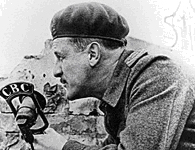
On June 6, the journalist Marcel Ouimet from the French network accompanied the Canadian troops that landed on the beaches of Normandy in France. He wrote copy in both French and English for Radio-Canada and the CBC respectively. Ouimet reached the Front in June 1943 accompanied by two other francophone colleagues, Paul Barette and Benoît Lafleur.
The Trio lyrique begins its performances on Radio-Canada.
1945
Official inauguration of the SRC’s International Service (later to become Radio Canada International in 1972)
The Radio-Canada French language network then counted seven (7) private affiliated stations:
CHGB, Ste-Anne-de-la-Pocatière, 250 watts
CHLT, Sherbrooke, 1,000 watts
CHNC, New Carlisle, 1,000 watts
CJBR, Rimouski, 1,000 watts
CJFP, Rivière-du-Loup, 250 watts
CKRN, Rouyn, 250 watts
CKCH, Hull, 250 watts
CKCV, Quebec City, 1,000 watts
1946
On an experimental basis, Radio-Canada set up an FM transmitter in Montreal.
Creation of the station Radio Saint-Boniface, in Manitoba, which thereby became the first French language network station outside of the Province of Quebec.
1948
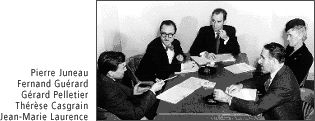
On August 26, the CBJ Chicoutimi station increased its transmitting power from 1,000 watts to 10,000 watts.
Début of the children’s show “Tante Lucille”. From 1948 to 1973, every Saturday morning, children could listen in to some 1,500 stories, from which Lucille Desparois eventually produced around forty books and about ten LPs.
In January, an explosion in the King’s Hall building in Montreal destroyed three radio studios. The incident will lead Radio-Canada to bring its employees all together under one roof and rethink the plan to centralize all its activities on Dorchester Boulevard West.
The first airing of the public affairs program, Les idées en marche, with Gérard Pelletier.
1950
Début of the series Nouveautés dramatiques, created by Guy Beaulne, which will be broadcast until 1962, as experimental Quebec theatre.
1951
Début of the series Sur toutes les scènes du monde, an international repertory theatre, which will remain on the air until 1975.
On May 18, inauguration of the new Radio-Canada studios in the old Ford Hotel on Dorchester Street.
1952
The French network became autonomous in terms of making decisions regarding its programming. Previously, all decisions had to be coordinated with senior programming management in Toronto.
1956
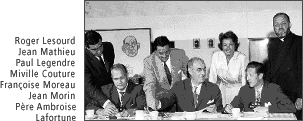
The director Paul Legendre creates Chez Miville, with Miville Couture, a show with humourous texts dealing with current events, which will remain on the air until 1970.
1960
Test of a bilingual FM network: Montreal, Ottawa, Toronto (abandoned temporarily in 1962).
Program début of Le cabaret du soir qui penche with host Guy Mauffette, which will remain on the air until 1973, and where music and poetry are married together.
1964
On August 1, the CBOF station was inaugurated in the Château Laurier in Ottawa.
1965
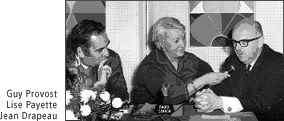
Program début of the first feminist show, hosted by Lise Payette, Place aux femmes, which will continue airing for five years. Lise Payette conducted interviews with various celebrities from the world of song, theatre, politics and sports. And, she will launch the most handsome man contest.
1966
Radio-Canada launched a daily open-line religious show hosted by Father Émile Legault. The program will last five years and attract some 300,000 listeners.
1967
Radio-Canada opened the CBUF-FM Vancouver station.
1969
Radio-Canada eliminated all advertising for tobacco.
1970
Lise Payette launched a new program, Studio 11, following Place aux femmes and it will be broadcast until 1972.
1971
Radio-Canada built a new transmission site in Brossard and closed down the Contrecoeur site, which had been inaugurated in 1937.
1972
Radio station CKBL Matane was acquired by Radio-Canada and became CBGA by extending its broadcast signal towards the Gaspésie and the Côte-Nord.
1973
On December 5, inauguration of the Maison Radio-Canada in Montreal, in the presence of Prime Minister Pierre-Elliott Trudeau.
The French network purchased radio station CKSB St-Boniface in Manitoba, as well as other stations in Gravelbourg and Saskatoon.
1974
Inauguration of the French language FM stereo network, linking Montreal, Ottawa, Quebec City and Chicoutimi.
Radio-Canada acquired the CFHA Edmonton station and extends its coverage of Western Canada.
Nearly total abandonment of advertising on the Radio-Canada radio network.
1975
Program début of “CBF-Bonjour” hosted by Jacques Houde.
The CJBR and CJBR-FM Rimouski stations became the property of Radio-Canada.
1977
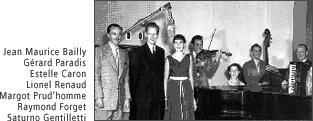
After 36 years, the end of the popular program Les joyeux troubadours, notwithstanding significant public protest. This program had been inspired by the CBC program “The Happy Gang”. The last ‘gang’ featured Gérard Paradis, Estelle Caron and Jean-Maurice Bailly.
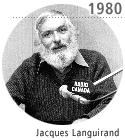
1980
Program début of Par quatre chemins with Jacques Languirand.
1985
The French language network undergoes the impact of $75 million in cutbacks imposed by the Mulroney Government.
1990
The Radio-Canada engineering division plays a decisive role in the development of digital radio.
1997
The CRTC approved Radio-Canada’s application to have CBF 690 kHz on the AM band move over to the FM band at a 95.1 MHz frequency.
The French network was renamed the Première chaîne.
1999
In order to improve the quality of the reception of the audio signal from the Première chaîne in the Greater Montreal area, the French language radio station petitioned the CRTC to increase the power of the 95.1 FM signal from 17,070 watts to 100,000 watts.
In June 1999, the CRTC rejected Radio-Canada’s application to create InfoRadio, a round-the-clock news network, by using it former 690 AM frequency. The CRTC preferred granting the frequency to CKVL. Seeing as during the process, the CRTC had allegedly erred in law and in exercising its jurisdiction, as well as allegedly basing its decisions solely upon technical considerations, rather than upon matters of content, Radio-Canada appealed the foregoing before the Federal Court of Appeal, on July 21. The appeal was dismissed by the Court in October.
2000
The Première chaîne is now well established almost everywhere across Canada and reaches 90% of the francophone population. The Chaîne culturelle reaches 80% of the francophones across the country.
Radio-Canada signed an agreement with CHLM FM, Rouyn-Noranda/Amos/Val d’Or, in order that the latter broadcast all Première chaîne programming throughout the Abitibi region.
2002
CKVM Ville-Marie and CFLM La Tuque disaffiliated from the Radio-Canada French language network, thus leaving only CHLM FM as a wholly affiliated station.
2004
On September 1st, the CRTC approved the acquisition by Radio-Canada of its last affiliated station, CHLM FM Rouyn-Noranda and its transmitter in Amos/Val d’Or.
2005
At 12:01 a.m. on August 15th, the CBC and Radio-Canada locked out 5500 of their employees (journalists, directors, production and administration), all members of the Canadian Media Guild, in all parts of the country, with the exception of the province of Quebec and the Moncton bureau, where other collective agreements were in force.
The lockout began after 15 months of unsuccessful negotiations. The labour dispute was essentially triggered by the Corporation’s desire to obtain more flexibility in its use of contract employees. The lockout deprived the French network of its regular news reports from other provinces, mainly from Ottawa, and foreign news reporters shared with the CBC English Network.
On October 11, after a 88.4% majority vote, employees started returning to work after accepting a new collective agreement which limited the number of contract employees that Radio-Canada/CDC could use.
Written by Yvon Chouinard – 2005
References:
Frequence/Frequency – 1997, 7-8; 2002, 9-10; 2004, 11-12; Association des études sur la radio-télévision canadienne
InfoScan – http://db.infoscan.urgence.qc.ca/crhono_rad.asp
Revue d’histoire de l’Amérique française – Vol. 51, no 3, hiver 1998 – Alain Canuel – Les avatars de la radio publique d’expression française au Canada 1932-1939
Idem – Vol. 52, no 2, automne 1998 – Alain Canuel – La censure en temps de guerre : Radio-Canada et le plébiscite de 1942.
SCHEC, Études d’histoire religieuses, 68 (2002), 7-23 – Pierre Pagé – Cinquante ans d’émissions religieuses à la radio québécoise, 1931-1983. De l’apologétique au dialogue avec les grandes religions.
Phonothèque québécoise http://www.phonotheque.org/radio/bibliographie.html
Radio UQAM – CHOQ FM – http://choq.fm?ssection=9&format=
DXingInfo – http://www.dxing.info/
L’encyclopédie canadienne – https://www.thecanadianencyclopedia.com/index.cfm?PgNm=TCE&Params=Q1SEC795709
Ville de Montréal – Montréal Clic – https://web.archive.org/web/20160309015138/http://www2.ville.montreal.qc…
Office de la langue française du Québec – http://www.olf.gouv.qc.ca/ressources/bibliotheque/
ouvrages/norme_medias_9798_term/terminogramme%20media_Dubuc.pdf
Rapport Juneau 1995 – https://www.canada.ca/home.html
Le Devoir – https://www.ledevoir.com/2004/06/05/56232.html
Early Radio History US – http://earlyradiohistory.us/1913call.htm
Université de Sherbrooke – Faculté des lettres et sciences humaines – Bilan du siècle – http://bilan.usherbrooke.ca/bilan/albumspublics.jsp
CBC/Radio-Canada – http://www.cbc.radio-canada.ca/en/explore/our-history/
Érudit – https://www.erudit.org/revue/haf/1998/v51/n3/005348ar.html
https://www.erudit.org/revue/haf/1998/v52/n2/005347ar.html
Études d’histoires religieuses, 68(2202), Pierre Pagé – Cinquante ans d’émissions religieuses à la radio québécoise, 1931-1983. De l’apologétique au dialogue avec les grandes religions.
http://localhost
Association des réalisateurs de Radio-Canada, http://www.realisateur.com/
